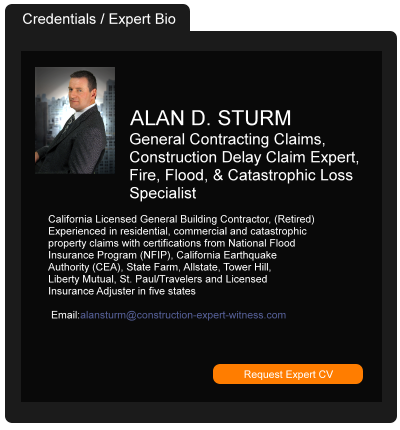Keep Your Construction Claims Alive in Crazy Economic Times
May 25, 2020 —
Christopher G. Hill - Construction Law MusingsCoronavirus is dominating the news. Construction in Virginia is facing what is at best an uncertain future and at worst a series of large scale shutdowns due to COVID-19. The number of cases seem to grow almost exponentially on a daily basis while states and the federal government try and patch together a solution. All of this adds up to the possibility that owners and other construction related businesses could shutter and importantly payment streams can slow or dry up. Aside from keeping your contractual terms in mind and meeting the notice deadlines found in your contract, these uncertain economic times require you to be aware of the claims process.
Along with whatever claims process is set out in the contract and your run of the mill breach of contract through non-payment type claims, in times like this payment bond and mechanic’s lien claims are a key way to protect your payment interest. The law has differing requirements for each of these unique types of payment claims.
Mechanic’s liens are technical and statute based with very picky requirements. The form and content of a memorandum of lien will be strictly read and in most cases form will trump substance. Further, among other requirements best discussed with a Virginia construction lawyer, you must keep in mind two numbers, 90 and 150. The 90 days is the amount of time that you have in which to record a lien. This deadline is generally calculated from the last date of work (or possibly the last day of the last month in which you did work). File after this deadline and your lien will be invalid because the right to record a lien has expired. The 150 days is a look back from the last day of work or the date of lien filing, whichever is sooner in time. The 150 days applies to the work that can be captured in the lien. In other words, it dictates the amount of the lien.
Read the court decisionRead the full story...Reprinted courtesy of
The Law Office of Christopher G. HillMr. Hill may be contacted at
chrisghill@constructionlawva.com
Be Careful with Mechanic’s Lien Waivers
June 09, 2016 —
Christopher G. Hill – Construction Law MusingsMechanic’s liens are near and dear to my heart here at
Construction Law Musings. These powerful tools can and should be properly used to help you, as a construction professional, get paid for your good work. Of course, the correct steps toward perfecting one of these liens must be followed, including being sure to
meet the stringent lien deadlines. I’ve discussed
the steps for filing such a lien and the various pitfalls relating to the
very picky statutory requirements for recording an enforceable memorandum of lien in Virginia.
One important area that I have not discussed as thoroughly as these basic requirements (and an area of which I have been
reminded by my pals at the Construction Payment Blog) is the area of mechanic’s lien waivers. While the Virginia General Assembly has
ended the days of pre-payment contractual waiver of mechanic’s lien rights for subcontractors and suppliers, mechanic’s lien waivers that waive rights either simultaneous with or after receipt of progress and final payments are still valid and used on a regular basis.
Read the court decisionRead the full story...Reprinted courtesy of
Christopher G. Hill, Law Office of Christopher G. Hill, PCMr. Hill may be contacted at
chrisghill@constructionlawva.com
Digitalizing Cross-Laminated Timber Construction
August 28, 2018 —
Aarni Heiskanen - AEC BusinessA Finnish experimentation project has made cross-laminated timber construction more productive and creative by using digital modeling.
The office of &’ [Emmi Keskisarja & Janne Teräsvirta & Company Architects Ltd] looks rather like a prototype workshop. Intriguing scale models, a 3D printer, and a small CNC machine all give clues about the architects’ current project. They’re determined to make wood construction more collaborative and creative using digital technologies and cross-laminated timber (CLT).
Plenty of Room for Improvement
“I’m going to present our KIRA-digi project at WDBE 2018 in September. Incidentally, our wooden installation will be on display during Helsinki Design Week,” says Keskisarja. “We want to communicate with the public, not just within our professional circles, as architects typically do. The theme of the week is trust, something that’s missing in today’s construction.”
Read the court decisionRead the full story...Reprinted courtesy of
Aarni Heiskanen, AEC BusinessMr. Heiskanen may be contacted at
aec-business@aepartners.fi
Developers Can Tap into DOE’s $400 Million for Remote and Rural Clean Energy Projects
December 10, 2024 —
Robert A. James, Elina Teplinsky, Alicia M. McKnight, Sidney L. Fowler & Clarence H. Tolliver - Gravel2Gavel BlogOn October 3, 2024, the Department of Energy Office of Clean Energy Demonstrations announced a Notice of Funding Opportunity (NOFO) to fund up to $400 million for clean energy projects in rural and remote areas via its Energy Improvements in Rural or Remote Areas program. The NOFO will provide awards ranging from $2 million – $50 million, with plans to fund 20 to 50 projects. Awards will require a non-federal cost share, range across four topic areas, and target projects in rural and remote communities with populations of 10,000 people or fewer.
Eligibility
Applications are open to a wide range of entities, including for-profit and nonprofit organizations, state and local governmental entities, Indian Tribes and Tribal organizations, institutions of higher education, rural electric cooperatives, incorporated and unincorporated consortia, farming associations and cooperatives, and labor unions. Generally applicants must be U.S. entities, but foreign entities may be allowed to participate in limited circumstances. Applicants must identify at least one area in the U.S. or U.S. territories with a population of up to 10,000 people which will benefit from the proposal.
Reprinted courtesy of
Robert A. James, Pillsbury,
Elina Teplinsky, Pillsbury,
Alicia M. McKnight, Pillsbury,
Sidney L. Fowler, Pillsbury and
Clarence H. Tolliver, Pillsbury
Mr. James may be contacted at rob.james@pillsburylaw.com
Ms. Teplinsky may be contacted at elina.teplinsky@pillsburylaw.com
Ms. McKnight may be contacted at alicia.mcknight@pillsburylaw.com
Mr. Fowler may be contacted at sidney.fowler@pillsburylaw.com
Mr. Tolliver may be contacted at clarence.tolliver@pillsburylaw.com
Read the court decisionRead the full story...Reprinted courtesy of
Hundreds of Coronavirus Coverage Cases Await Determination on Consolidation
September 21, 2020 —
Tred R. Eyerly - Insurance Law HawaiiOn July 30, 2020, the Judicial Panel on Multi-District Litigation (JPML) heard oral argument on the potential consolidation of all federal cases involving business interruption coverage relating to coronavirus and shut-down orders. A decision will be rendered in the near future.
Meanwhile, many cases are on hold, waiting for a determination on consolidation. One such case is Pigment Inc. v. Hartford Fin. Servs. Group, 2020 U.S. Dist. LEXIS 133230 (S.D. Cal. July 27, 2020), where the court granted a stay pending a decision by the JPML. The case is a class action based on denial of coverage under business interruption insurance. Plaintiff's case alleged a bad faith denial that risked the permanent closure of its business due to unexpected temporary shutdowns from the COVID-19 pandemic. Plaintiff sought a stay pending the decision of the JPML.
The court considered the possible damage which could result from granting a stay, the hardship which a party could suffer in being required to go forward, and the orderly course of justice measured by the simplifying or complicating of issues, proof, and questions of law which could be expected to result from a stay.
Read the court decisionRead the full story...Reprinted courtesy of
Tred R. Eyerly, Damon Key Leong Kupchak HastertMr. Eyerly may be contacted at
te@hawaiilawyer.com
Word of the Day: “Contractor”
September 16, 2024 —
Garret Murai - California Construction Law BlogWhat’s in a word? When it comes to insurance policies, a word, can potentially mean millions of dollars.
In
California Specialty Insulation, Inc. v. Allied World Surplus Lines Insurance Company, 102 Cal.App.5th 1 (2024), an insured and its insurer battled it out over the word “contractor,” and whether an exclusion from coverage of bodily injury to any employee or temporary worker “of any contractor or subcontractor,” excluded a personal injury claim brought by an employee of a general contractor against a subcontractor.
The California Specialty Contractor Case
In 2017, Air Control Systems, Inc. (“Air Control”) was contracted to perform improvements at a building in Los Angeles, California. Air Control in turn subcontracted with California Specialty Insulation, Inc. (“CSI”) to install duct insulation on the project.
During construction, an employee of Air Control was injured when he fell 16 to 20 feet from a ladder that was struck by a scissor lift driven by an employee of CSI. Approximately two years later the Air Control employee filed a personal injury lawsuit against CSI.
Read the court decisionRead the full story...Reprinted courtesy of
Garret Murai, Nomos LLPMr. Murai may be contacted at
gmurai@nomosllp.com
Renters Who Bought Cannot Sue for Construction Defects
October 08, 2013 —
CDJ STAFFA Wisconsin couple that leased then bought a home cannot sue the couple that built the home for construction defects. The court rejected the claims made by Niksa and Kelly Ivancevic that the sellers, Ronald and Debra Reagan, had breached contract or that the contract represented a mutual mistake.
The Ivancevics initially leased the home, with an agreement that said the house would be “delivered in clean condition and good repair, free of mold and toxic substances, suitable for habitation in compliance with all laws.” Before the purchase, no defects were found. After the purchase, the Ivancevics had problems with the air conditioning, leading to water leaks on the second floor.
The court found that the actual sales contract did not guarantee a defect-free residence. Therefore the Ivancevic’s claim of a mutual mistake, in which “both parties of a contact are unaware of the existence of a past or present fact material to their agreement” did not apply, since the presence of construction defects was not “material to their agreement.”
Read the court decisionRead the full story...Reprinted courtesy of
The Fifth Circuit, Applying Texas Law, Strikes Down Auto Exclusion
July 11, 2022 —
Jeremy S. Macklin - Traub Lieberman Insurance Law BlogPenn-America Ins. Co. v. Tarango Trucking, LLC, 30 F.4th 440 (5th Cir. 2022), involved a coverage dispute over Penn-America Insurance Company’s (“Penn-America”) duty to defend and indemnify third-party claims against Tarango Trucking, LLC (“Tarango”) for a fatal accident on its property. At the time of the accident, Penn-America insured Tarango under a commercial general liability policy, which included an “Auto Exclusion” and “Parking Exception” provision. The Auto Exclusion stated the policy did not apply to bodily injury or property damage arising out of the use of any automobile, including the operation and loading or unloading. The Parking Exception stated the Auto Exclusion did not apply to parking an auto on Tarango’s premises. The main issues on appeal were whether the Parking Exception restored coverage otherwise precluded by the Auto Exclusion, and whether the district court prematurely decided Penn-America’s duty to indemnify. The appellate court answered yes to both.
On March 2, 2020, a truck driver employed by WS Excavation, LLC (“WS”), parked his tractor-trailer on Tarango’s property and proceeded to inspect and off-load heavy equipment. While operating the hydraulic lift, the tractor’s braking system disengaged. The tractor rolled back and struck the WS driver and his personal vehicle, resulting in his death and significant property damage. Notably, WS allegedly failed to properly maintain the tractor’s electronic and braking systems, and Tarango allegedly failed to maintain a level parking and loading facility compliant with industry standards and guidelines.
Read the court decisionRead the full story...Reprinted courtesy of
Jeremy S. Macklin, Traub LiebermanMr. Macklin may be contacted at
jmacklin@tlsslaw.com


































































